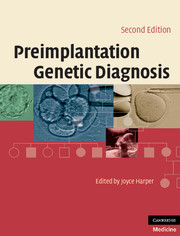Book contents
- Preimplantation Genetic Diagnosis
- Preimplantation Genetic Diagnosis
- Copyright page
- Contents
- Contributors
- Preface
- Section 1 Background
- Chapter 1 Introduction to preimplantation genetic diagnosis
- Chapter 2 Assisted reproductive technologies
- Chapter 3 Genetic basis of inherited disease
- Chapter 4 Genetic counseling
- Prenatal screening and diagnosis
- Chapter 6 Preimplantation embryo development
- Chapter 7 Preimplantation genetics
- Section 2 Procedures used in preimplantation genetic diagnosis
- Section 3 Ethics and the future
- Index
Chapter 2 - Assisted reproductive technologies
from Section 1 - Background
Published online by Cambridge University Press: 09 November 2009
- Preimplantation Genetic Diagnosis
- Preimplantation Genetic Diagnosis
- Copyright page
- Contents
- Contributors
- Preface
- Section 1 Background
- Chapter 1 Introduction to preimplantation genetic diagnosis
- Chapter 2 Assisted reproductive technologies
- Chapter 3 Genetic basis of inherited disease
- Chapter 4 Genetic counseling
- Prenatal screening and diagnosis
- Chapter 6 Preimplantation embryo development
- Chapter 7 Preimplantation genetics
- Section 2 Procedures used in preimplantation genetic diagnosis
- Section 3 Ethics and the future
- Index
Summary
- Type
- Chapter
- Information
- Preimplantation Genetic Diagnosis , pp. 48 - 72Publisher: Cambridge University PressPrint publication year: 2009

